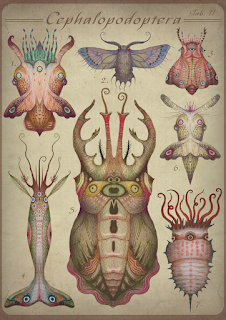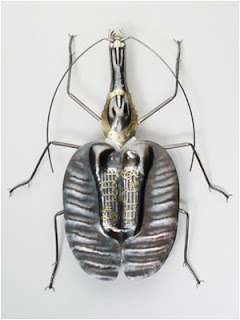For some reason, I've been seeing a quite a few insects in art of late. After the recent post on the photographic work of Laurent Seroussi, today I bring you more than 2D insects: sculptural and animated fanciful insects.
Working with trash (and found objects), British artist Mark Oliver has created the 'litterbugs', building their bodies and classifying his imaginary creatures with scientific and common names. The 'muscle bug (Coleoptera Tendonitis)' for instance involves anatomical illustrations of the muscles in human limbs. The 'frequency moth (Lepidoptera Doppler)' has clock arms for legs. The 'celebellar bug (Coleoptera Mesmerical)' contains anatomical drawings of human heads and brains. Some are more metaphorical in classification. The 'Prophet Moth (Lepidoptera Inspiration)' contains the spine of a bible. He describes his beautiful and whimical Litter Bugs thus as, "A creature whose instinctual and physical qualities have adapted so uniquely to the modern urban environment that it has rendered itself, by nature of camouflage, virtually invisible" in its habitat. They make a truly wonderous collection; be sure to peruse the whole collection.
(↬design boom)
Mark Oliver isn't the only artist inventing species of insects. The previously mentioned Finland-based artist Vladimir Stankovic invented Cephalopodoptera, which, as the name suggests, combines the cephalopods (octopi and squids) with insects. What makes them magical is that he has not only illustrated them but animated them, like the often colour-changing or bioluminescent cephalopods. Find more here.
Cephalopodoptera by Vladimir Stankovic
Cephalopodoptera by Vladimir Stankovic
I am really taken with the work of Canadian metalsmith and jeweller Elizabeth Goluch. Her gorgeous metal and gemstone insect sculptures include clever little allusions to nomenclature or folklore. There are a dragons and flies on her dragonfly. Insider her ladybugs are a house engulfed in flames ("Ladybug, ladybug, fly away home. Your house is on fire..."). Her Violin Beetle has a violin, bow and scored music included. Her carpenter arts contain the tools of the trade (hammer, nails and saw). Her work isn't limited to insects; I love the medusa jellyfish with medusa head. Have a look at her marvellous portfolio.
DRAGONFLY by Elizabeth Goluch
Sterling silver, 18k & l4k gold, fresh water pearls, garnets
9.5"l x 11.75"w x 2.75"h
LADYBUG #2 by Elizabeth Goluch
sterling silver, 18k + 14k gold, garnets, enamel, ceramit
5.5"l x 4.5 "w x 1.5 "h
 VIOLIN BEETLE by Elizabeth Goluch
VIOLIN BEETLE by Elizabeth Goluchsterling silver, 18k & 14k gold
10.5"l x 8.5"w x 1.5"h
CARPENTER ANTS by Elizabeth Goluch
Sterling silver, 14K & 18K gold
8.5"l x 7.25"w x 2.25"h
10"l x 8.75"w x 3"h
9"l x 7"w x 2.75"h
This work reminds me of the Insect Lab Studio. "Borrowing from science fiction and fact, Insect Lab customizes insect specimens with antique watch parts and other mechanical components for a luxurious and whimsical effect." Insect Lab creates sort of steampunk robot-like insects; they don't function robotically, but they merely look like Victoria cyborg insects (or cybugs).
Cetonidae: Amaurodes Passerinii Linnei by Insect Lab
Steel watch parts, gears and screw
2.75"
3"x4" dome
Cetonidae: Dicarphaneous Adamsi by Insect Lab
Steel watch parts, gears, spring and screw
3"
4"x4" dome
Cerambycidae: Batocera Numitor by Insect Lab
Steel pocket watch parts, gears, springs and shafts.
5"
5.5"x5.5" dome
I notice that what all these bespoke insect sculptures (and animations) have in common is that they are made of disparate parts. This seems entirely apt. The word insect itself means segment or cut, refering to their separate parts.

























No comments:
Post a Comment